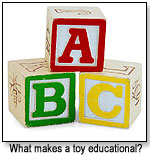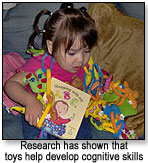 |

Tools:








What Makes a Toy Educational?
| “The truth is that all experiences develop the brain..” — Susan Hardwicke, Ph.D. |
Do “educational toys” actually deliver what they promise? A psychologist slices through the hype and offers words of wisdom for the discerning parent.
 In the present economy, the educational toys category is one of the few growth areas of the toy industry. I predict an even greater scramble to parade, perhaps even exaggerate, the educational benefits of toys in the marketplace as each vendor vies for a larger share of this hot category. In the present economy, the educational toys category is one of the few growth areas of the toy industry. I predict an even greater scramble to parade, perhaps even exaggerate, the educational benefits of toys in the marketplace as each vendor vies for a larger share of this hot category.
Retailers are challenged to sift through the claims and “edu-speak” and select items that have both kid appeal and real benefit. A key selling point for an educational toy is its ability to offer a broad spectrum of benefits, maximizing purchase opportunities and minimizing the likelihood that only a few of a child’s skills are really being developed.
The growth of the educational toy market can be traced to parents’ belief that they need to supplement school-based learning -- particularly in light of the rapidly evolving job marketplace -- and that toys can have at least a moderate impact on learning. These two beliefs correspond to two basic types of educational toys: “curriculum,” or content-based, and “cognitive,” or skill-based.
Evaluating Curriculum-Based Toys
 These types of toys are designed to increase a student’s knowledge in a subject, such as science or history, and they are easier to evaluate than cognitive learning toys. Evaluation factors include: These types of toys are designed to increase a student’s knowledge in a subject, such as science or history, and they are easier to evaluate than cognitive learning toys. Evaluation factors include:
1. Breadth, depth and clear statement of knowledge to be gained, taking into consideration the target age group. Shallow or narrow content products will tend to have limited re-playability or a very narrow audience. Exercise caution when marketing terminology is vague, such as “builds knowledge and interest.” Such wording may have some immediate appeal, but close examination will show that evaluating a product on this basis would be difficult or fruitless.
2. Building knowledge of “how” and “why” versus presentation of facts and concepts. Generally, understanding the “hows and whys” helps learning facts and ideas.
Evaluating Cognitive-Based Toys
Playtime, and therefore any toy a child engages with during playtime, does affect the brain. Research supports the idea that interactive toys can especially contribute to cognitive skills.
Toys that boast cognitive benefits should be even more popular in the next five years as more media attention is focused on the relationship between the brain and academic success. Bear in mind, however, that it is important to read carefully and differentiate the real from the presumed and the vague from the specific.
Evaluation factors include:
 1. Description of very specific skills to be developed. “Improves learning,” and “Makes children smarter,” and even the technical-sounding "Enhances cognitive development” are too vague. To a parent, the statement may mean that a child’s intelligence, as measured by tests, will increase as a direct result of playing with the toy. To an educator, the statement may mean that knowledge of content or curriculum is increased. To the developer, it may mean that the toy increases the number or depth of skills. Such statements should be defined in more detail. The key to selecting cognitive educational toys is to choose those that develop a number of different skills that are ultimately used in complex ways later in life. 1. Description of very specific skills to be developed. “Improves learning,” and “Makes children smarter,” and even the technical-sounding "Enhances cognitive development” are too vague. To a parent, the statement may mean that a child’s intelligence, as measured by tests, will increase as a direct result of playing with the toy. To an educator, the statement may mean that knowledge of content or curriculum is increased. To the developer, it may mean that the toy increases the number or depth of skills. Such statements should be defined in more detail. The key to selecting cognitive educational toys is to choose those that develop a number of different skills that are ultimately used in complex ways later in life.
2. Availability of research data obtained by the vendor. Ideally, the vendor should be willing to provide data to substantiate claims. Research should be of two types:
- a. Articles and studies that support the approach taken by the product developer
- b. Research that involves the product. Statements such as “helps in developing vocabulary” can and should be backed up by studies involving the product.
Red Flags
The Internet provides a wealth of opportunity to gain information about a product. Unfortunately, the quality and validity of information can be severely lacking. Companies cannot control all of the information about their product, but they should not create disinformation, either. When reading product reviews, ensure that reviewers are independent or recognized by the industry or by relevant professional associations.
There’s No Substitute for Expertise
With today’s emphasis on learning, it’s not enough to rely on past trends to predict future ones. In order to become an astute evaluator of toys’ educational benefits, it will become increasingly necessary to stay current with emerging knowledge about learning and the brain.
Click here to see Educational Products recently added to TDmonthly
 Writer's Bio: Writer's Bio:
Dr. Hardwicke is a psychologist specializing in measurement, assessment, and cognitive development. One of the pioneers in online educational testing, Dr. Hardwicke has also founded kSERO Corporation, Inc. ( www.cognitivepix.com) to develop the human capacity to learn. kSERO Corporation recently received a federal grant to pursue its innovative approach to cognitive learning. Read more articles by this author
THIS BANNER IS AN AD:

• • • • • • • • • • • • • • • • • • | • • • • • • • • • • • • • • • • • • |
Back to TDmonthly's front page
|  |
Advertise on TDmonthly

|

